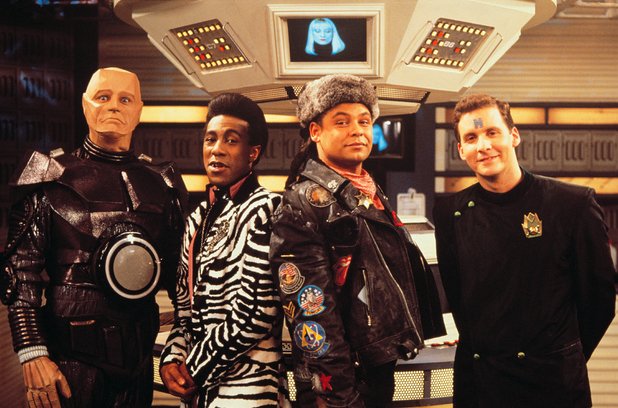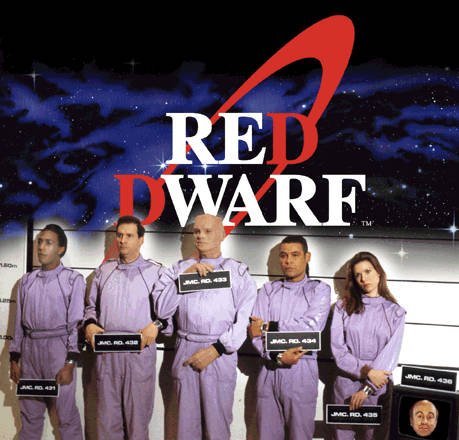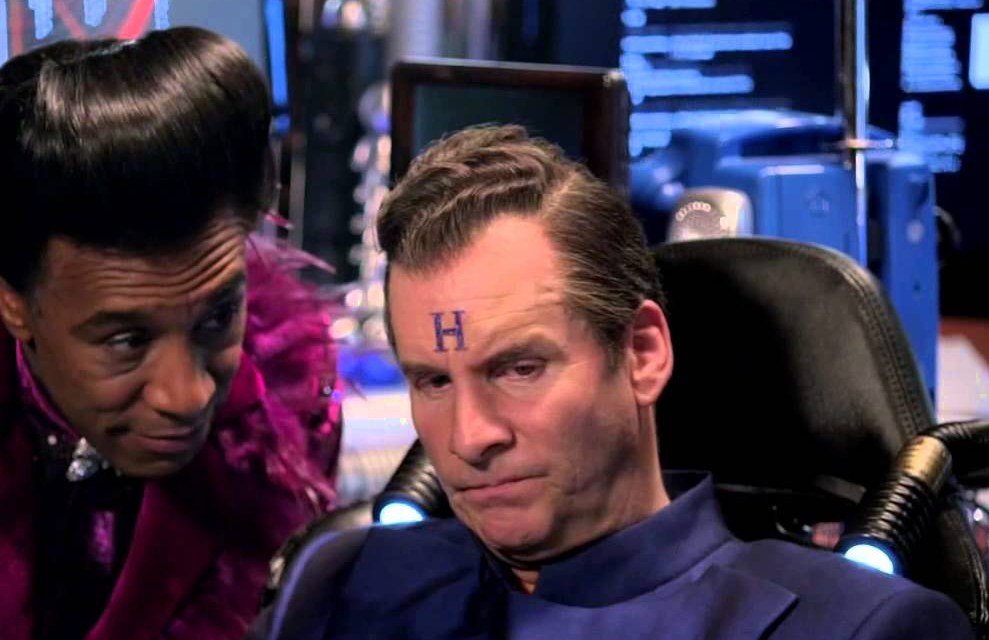Red Dwarf – The Perfect Combination of Comedy and Sci-Fi?
If I’m being honest, I don’t remember the first time I watched Red Dwarf but I do remember the moment it had become an obsession.

I decided that having Red Dwarf on VHS wasn’t enough for me and I hatched a plan. Using a radio cassette player/recorder and a blank TDK D90 I stacked up some boxes so that the mic was level with the TV speaker, set up the video to the beginning of the programme and pressed record. Viola! I had an audio recording of the first three episodes of Red Dwarf series one that I could carry around with me in my walkman. I was a genius. A genius who learnt those three episodes, The End, Future Echoes and Balance Of Power off by heart. Red Dwarf is the kind of programme that inspires that kind of geekery. It has been welcomed into the sci-fi realm despite only having one plot point that remains constant throughout its 10 series, due to the fact that amongst the high gag rate there was always actual complex sci-fi ideas .Indeed, if the idea of the last human on a space ship three million years from Earth (Lister), with a holographic reproduction of his bunkmate (Rimmer), a humanoid cat (erm… Cat), an increasingly dim-witted ships computer (Holly) and later a neurotic robot (Kryten) isn’t enough of a sci-fi concept for you, by the second episode (Future Echoes) things got really high minded.
After accelerating for three million years Red Dwarf breaks light speed and it’s not long before the crew encounter problems, witnessing things that haven’t happened yet – things they can see but can’t interact with, leading to increasingly confusing encounters with themselves. That’s just episode two. You rarely see ‘proper’ sci-fi programmes attempting that so early in a show nowadays, because TV bosses are worried people might not keep up. And series one didn’t stop there. Confidence and Paranoia gave Lister a mutated virus that made his feverish hallucinations flesh, Waiting for God made Lister the god of the cat race and Me2 explored what would happen with a duplicate Rimmer on board.
To Red Dwarf’s credit, the show never shied away from making the concepts, if anything, more complex. Over the years Red Dwarf‘s creators Rob Grant and Doug Naylor would dally with the concepts of parallel dimensions, time travel, multiverses, white holes, planets that form from a person’s psyche and gestalt entities. In fact it could be argued that despite essentially being a sitcom Red Dwarf‘s strongest suit has always been stories. Even when the laughs were thin on the ground – which may or may not have happened the day Rob Grant walked away – Doug Naylor could always be relied upon to provide an engaging, solid story. Most Red Dwarf fans would agree that the show reached its peak over the first six series with barely a duff episode cropping up in that thirty six show run but as the programme continued, even with less laughs, the stories held their own, often making Red Dwarf seem more like a sci fi programme with comedic elements rather than vice versa.

After a three year break Red Dwarf returned for series VII minus one creator and about to lose a main character in Rimmer. Chris Barrie only returned for a few episodes leaving in episode 2 – Stoke Me a Clipper – and appearing in flashbacks in Blue. Filling this not inconsiderable comedic gap fell to Chloë Annett who played the role of Lister’s love interest Kristine Kochanski. This surprised many Dwarf purists who, after Clare Grogan’s (the original Kochanski) blink and you’ll miss it return to the role in series 6, were probably expecting something different but Annett went on to make the role her own.
Grant’s departure was evident as the show’s emphasis seemed to be more on story and Naylor experimented with a series long story arc that was absent in previous runs, but the change was met with mixed reactions. The fans were confused by the stark change in style, what had been a gradual change over the previous series was jarring in this one. Due to the larger break between the series, it was probably something Naylor had been ruminating on for a while so he was perhaps unaware just how much of a shock it was seeing this new “filmic” style. As such the episodes in VII are an oddity in the Red Dwarf canon, not least because the cast were trying to adapt to the lack of studio audience and as such the performances were slightly off. Also the story Naylor attempted to tell became slightly rushed because in the first episode the aftermath of series VI had to be dealt with, Rimmer written out by the episode two and Kochanski introduced by the third. As such, although the stories were strong with plenty of gags along way series VII was not quite Red Dwarf.

If VII suffered from the loss of two key players, VIII overcompensated somewhat with the return of not only Chris Barrie but also Norman Lovett as Holly – last seen in series 2, Mac Macdonald as Captain Hollister and bit parts for Paul Bradley and David Gillespie as Lister’s best friends Shen and Selby. Mark Williams unsurprisingly didn’t reprise his role as Petersen – he was not only still very much part of The Fast Show but he was also starring in Rob Grant’s short lived The Strangerers – so things might have gotten a bit wierd.
Series VIII followed on from the series VII trend and continued being more story based with an overall arc, but the emphasis seemed to be back on the daftness, perhaps thanks to the return of Rimmer and the chance for Lister/Rimmer interplay, the back bone of many of the funniest scenes in Dwarf history.
Then the show disappeared – again.
It would be the TV channel Dave that ressurected the show with a three part special.
With Back to Earth the style changed again and was shot more like a film on a scant budget, Again, like series VII Back To Earth received mixed reactions from the fans with some horrible reviews, which is a shame because a quick re-watch proves it to be somewhat of a misunderstood gem, and a love letter to the fans in many ways. Granted, like VII it suffers from the absence of a studio audience for the cast to play off and the performances are slightly stunted but the story is solid and incredibly, painstakingly meta with a rapid line of (in)jokes peppering the script.

Firmly back in the nations consciousness Series X was a return to past glories for Red Dwarf. After Doug Naylor’s attempts in the previous three series to move away from the “monster of the week” format they had perfected in the first six he obviously realised that for a sitcom like Red Dwarf there’s actually nothing wrong with a “monster of the week”. As his solo Red Dwarf novel, Last Human attested, within him there’s an urge to write something more dark and serious and classically sci-fi, but Red Dwarf is not the forum for that. So X became the series where the jokes became king once more, and the stories were streamlined to make way for the comedy beats.
In this series there’s Rimmer’s brother Howard, Jesus, a groin exploder, Lister trying – as his own father – to get his life into shape, and a vending machine love triangle. All hallmarks of classic Dwarf but it’s in the last episode of the series that everything really comes together. Utilising Rimmer’s neurosis as a catalyst once more, along with the ever entertaining deadly simulants the story centres on Rimmer having to step up and be a hero. Combine this with a high gag rate and it’s up there with some of the best Red Dwarf episodes.
Now with Season XI apparently on the horizon and series X being a massive return to form, Red Dwarf – unlike other resurrected shows – isn’t quite dead yet.
Feature Image credit – reddwarf.wikia.com

